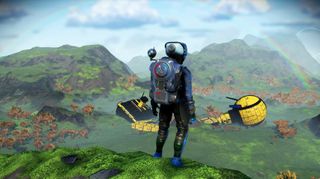No Man's Sky boosts AMD performance with Vulkan API support
Warp speed for AMD GPU owners, but Nvidia gamers will be far less impressed by the update.

Part of the No Man's Sky Beyond update will include a full overhaul of the graphics rendering API, switching from OpenGL to Vulkan. While the final release of the Vulkan update won't be available until Beyond is finished, Hello Games is excited enough about the improvements it's seeing that it has made the Vulkan update available on the experimental branch. I haven't played NMS for a while, but with the announcement I thought I'd perform some quick tests to see how much the update does—or doesn't—improve performance.
First, to install the experimental branch, you'll need to open up the NMS properties panel in steam, go to the Betas tab, and input "3xperimental" into the text box. Once you've pressed the Check Code button, you should be able to select the "experimental - Experimental" beta from the dropdown list. That should also initiate a 3.8GB update to NMS, and once it's complete you can give the Vulkan patch a try.
Hello Games recommends backing up your saves before playing with the experimental branch (they're in your AppData\Roaming\HelloGames\NMS folder), as switching back to the standard branch with an updated save file could cause problems. Also note that switching back to the main branch will download a 5.6GB update, so you probably don't want to switch back and forth several times. (Don't ask me how I know this.) But let's talk numbers for a minute.
I tested No Man's Sky on a GTX 1080 Ti and a Radeon VII, not necessarily the best graphics cards, at maximum quality. These two graphics cards should have relatively similar performance based on testing in other games, though to be fair we're comparing a two-year-old discontinued Nvidia card with AMD's latest and greatest. I ran around on a planet for a minute or so, logging frametimes, and did this at 1080p, 1440p, and 4K.
Without Vulkan, the GTX 1080 Ti scored 155/109 fps at 1080p (that's average and minimum fps), 119/80 fps at 1440p, and 66/46 fps at 4K. So far so good. AMD's Radeon VII meanwhile was a shockingly bad experience. The first run at each resolution had frequent stuttering, with minimum fps dipping into the teens at all three resolutions. 1080p ran at 59/14 fps, 1440p at 48/12 fps, and 4K at 35/12 fps. A second run of each resolution (right after the first) did better, but still nowhere near what I expected: 1080p got 71/45 fps, 1440 at 61/37 fps, and 4K at 40/24 fps. Not to put too fine a point on it, but the Radeon VII without the Vulkan update is running at roughly half the expected framerate. Ouch.
The Vulkan update basically fixes things. Once that's installed, the Radeon VII scores 146/110 fps at 1080p, 110/86 fps at 1440p, and 61/48 fps at 4K. Average framerates are still slightly slower than the GTX 1080 Ti, but that's about what I expect. Meanwhile, for Nvidia (at least on Pascal architecture GPUs—I didn't test any RTX cards), the Vulkan update appears to drop performance a bit: the GTX 1080 Ti gets 147/108 fps at 1080p, 107/74 fps at 1440p, and 59/45 fps at 4K. That's about 10 percent lower, whereas the AMD GPU nearly doubled its performance.
Obviously the results can and will differ with other GPUs, but since this is a beta Vulkan build I didn't go any further. There's still work to do before the Beyond update is out, but if you want to give it a shot (and you should if you're playing NMS on an AMD GPU), Hello Games is also accepting reports of bugs and issues with the experimental branch.
The biggest gaming news, reviews and hardware deals
Keep up to date with the most important stories and the best deals, as picked by the PC Gamer team.
Jarred's love of computers dates back to the dark ages when his dad brought home a DOS 2.3 PC and he left his C-64 behind. He eventually built his first custom PC in 1990 with a 286 12MHz, only to discover it was already woefully outdated when Wing Commander was released a few months later. He holds a BS in Computer Science from Brigham Young University and has been working as a tech journalist since 2004, writing for AnandTech, Maximum PC, and PC Gamer. From the first S3 Virge '3D decelerators' to today's GPUs, Jarred keeps up with all the latest graphics trends and is the one to ask about game performance.
Most Popular




